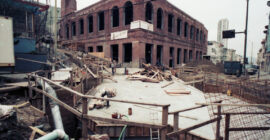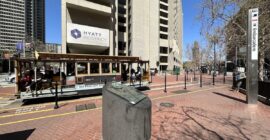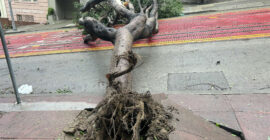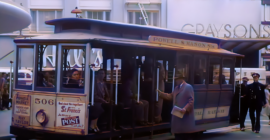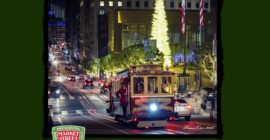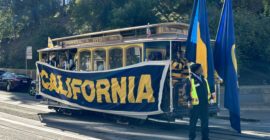Cable cars, a giant leap forward in urban transit technology when Andrew Hallidie invented them in 1873, dominated San Francisco streets until the earthquake and fire of 1906 decimated both cable machinery and the cars themselves. After that, cable cars were largely limited to steep hills while larger, faster electric streetcars carried the heavy loads on main routes. High operating costs gradually pared down the remaining cable car lines. In 1947, an attempt by a misguided mayor to junk the Powell Street cables was slapped down by a women-led civic coalition helmed by Friedel Klussmann, but even her heroic efforts seven years later could not avert the loss of half the remaining cable car trackage.
Streetcars and Cable Cars
When cable cars were hi-tech
Innovation born in San Francisco triggered a hi-tech revolution that changed America and much of the world. We’re not talking here about the digital innovations from Silicon Valley. Nor the analog innovation by Philo T. Farnsworth, in a little building on Green Street in 1927, that gave birth to television. We’re talking about mechanical innovation 150 years ago that began a revolution in how people move around cities.
Market & California, now and then (and then, and then…)
The California Street cable car line has terminated at Market Street since 1891. For the past 50 years, its neighbor has been the Hyatt Regency, the innovative hotel designed by John Portman, now iconic in its own right. When the hotel’s current management generously supported the celebration of 150 Years of Cable Cars, they asked us if we had some old photos of the location.
Red Arrow hits target
After a spectacular restoration, a 1940s streetcar paying tribute to Philadelphia’s “Red Arrow” lines is again carrying passengers on the streets of San Francisco.
Cable car plea: fix the ficus
Wind and wet felled hundreds of trees in the Bay Area this winter, but one species in particular is dangerous to the cable cars. On March 21, most cable car lines were shut down by blown-down Ficus macrocarpa ‘Nitida’ trees and limbs.
Color cable car flashback
As part of our celebration of 150 Years of Cable Cars, we’re sharing clips and photos we’ve found online that take you back to earlier decades.
Melvin Van Peebles, Cable Car Gripman
We’ve written before of the many Black barrier breakers in San Francisco transit. These are stories that must be retold every month, not just Black History Month. People such as Mary Ellen Pleasant, Charlotte Brown, Audley Cole, Larry Martin, Welton Flynn, Curtis Green, and Maya Angelou confronted racism and resistance; all moved the needle in our City toward equity and equality, a fight that continues today.
The cable car tower
Since 1888, a small wooden structure has stood on the southeast corner of Powell and California Streets. It’s an essential sentinel protecting the world’s only cable car crossroads. Here’s its story.
Looking back – and forward
In 2023, we will celebrate 150 years of cable cars AND the 40th anniversary of the first Historic Trolley Festival that led to the permanent F-Market & Wharves vintage streetcar line.
CAL-ble Car
It’s Big Game week in the Bay Area. (To those reading this from elsewhere, it’s our biggest college football rivalry: University of California, Berkeley, known to all its fans as simply Cal, vs. Stanford University. ) The first Big Game was in 1892, four years after cable car service started on Powell Street, one year after cable cars started running on Hyde.
Archive: All Posts
